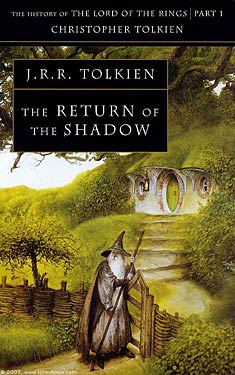JRR Tolkien and Christopher Tolkien
Completed 7/23/2017, reviewed 7/25/2017
4 stars
This is the sixth volume of the History of Middle Earth (HOME)
series and the first of the History of the Lord of the Rings sub-series. It covers the first several drafts of the
beginning of The Lord of the Rings. I
really enjoyed this book. It was a nice
break from the first five volumes which look at the stories that make up The
Silmarillion. I’m sure I liked this book
because I’m more familiar with the LOTR than I am with the Silmarillion stories
and I’m enjoying the break from them. Different
is good, especially when you’re getting twelve volumes of drafts and notes and
research.
 Perhaps the most fun of this book is finding out Tolkien’s
original names for the characters. Frodo
was Bingo. I think everyone is glad this
eventually got changed. Between the
song, “And Bingo was his name-o”, and the game, I think the name would have
been too distracting. In actuality,
Bingo is named after a family of stuffed bears Tolkien’s children had. Frodo was one of the companion hobbits. In addition, Aragorn was a hobbit named
Trotter, and Pippin was Marmaduke. So lots
of changes took place between the original drafts and the final addition.
Perhaps the most fun of this book is finding out Tolkien’s
original names for the characters. Frodo
was Bingo. I think everyone is glad this
eventually got changed. Between the
song, “And Bingo was his name-o”, and the game, I think the name would have
been too distracting. In actuality,
Bingo is named after a family of stuffed bears Tolkien’s children had. Frodo was one of the companion hobbits. In addition, Aragorn was a hobbit named
Trotter, and Pippin was Marmaduke. So lots
of changes took place between the original drafts and the final addition.
The thing to remember when reading this and keeping in mind
all these name changes is that LOTR was a sequel to The Hobbit. With these early drafts, it’s clear that the
Tolkien’s intention was to come up with another adventure for hobbits, not the thousand-page
saga of apocalyptic proportions that it turned into. There’s a lot of hobbit banter, that is, rather
silly conversations between the hobbits that amused Tolkien and his son, but
would have been remembered today as goofy, less risqué Monty Python-esque
absurdities. Think of Pippin’s silliness
multiplied by four. The story didn’t
become serious until the first Black Rider appeared, something that surprised
Tolkien himself as he wrote it.
It’s not until Trotter (the future Aragorn) tells the tale
of Beren and Luthien that Tolkien starts to bring in the whole Middle Earth
mythology. Suddenly, LOTR becomes part
of the universe of the Silmarillion. The
nature of the Ring grows from just being a simple magic trick to something much
more dangerous. Things come together and
soon the drafts transform into the text we are all more familiar with.
This book doesn’t cover the whole Fellowship of the
Ring. It stops at the Mines of
Moria. Aragorn is still Trotter, and
Gimli and Legolas are still not formed either.
It’s only 1939-1940 and Tolkien is still getting stuck. I think it’s funny that Tolkien sends updates
to his publisher that chapters are being completed when he still doesn’t know
where the story is really going.
I’m looking forward to the next three volumes. As usual, I followed along with Corey Olsen,
the Tolkien Professor and his Mythgard Academy textual analysis of the
book. This makes it much more
readable. I have to admit, some of
Christopher Tolkien’s background is very dry, but Olsen’s analysis breathes
life into the history of the stories. I
give the book four stars out of five and as usual give the warning that this is
pretty much a book for fans like me, a dedicated geek.
No comments:
Post a Comment